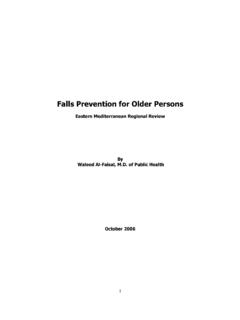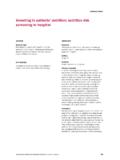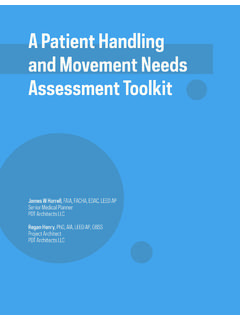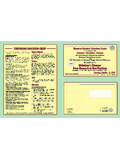Transcription of SCOPE and STANDARDS of ASSISTED LIVING …
1 SCOPE & STANDARDS RN FINAL 09 18 06. SCOPE and STANDARDS . of ASSISTED LIVING nursing PRACTICE. for REGISTERED NURSES. Background The SCOPE and STANDARDS of ASSISTED LIVING nursing Practice was written with several purposes in mind: (1) to describe the ethical obligations and duties of the ASSISTED LIVING nurse; (2) to guide the practice and conduct of the ASSISTED LIVING nurse; and (3) to articulate the ASSISTED LIVING nurse's understanding of the professions commitment to health care , nursing , and society. Written in 2007, the SCOPE and STANDARDS for ASSISTED LIVING practice reflect a relatively new nursing practice specialty that did not exist 15 years ago. Often compared to a nursing home nurse, particularly with regard to these practitioners' relative isolation from collegial and interdisciplinary/interprofessional discourse, the ASSISTED LIVING nurse is an even more autonomous decision maker and manager of care and systems as compared to the acute care The nursing role may be a joint role as administrator/wellness coordinator, generally overseeing the well-being of the residents.
2 An additional or independent role might be that of a consultant, reviewing health records and guiding unlicensed staff in optimization of residents' function and quality of life, monitoring residents' chronic illness status, or assessments during acute changes of condition. ASSISTED LIVING facilities (ALFs) are residential long term care settings that provide housing, 24- hour oversight, personal care services, health related services, or a combination of these on an as needed basis1. A physical environment is created specifically to avoid the appearance of an institutional or medical-type of facility. ALFs provide care to a vulnerable and medically, functionally, and cognitively impaired population 2-5 the majority of who require some assistance with activities of daily LIVING (ADLs) and instrumental activities of daily LIVING (IADLs) 3, 4, 6.
3 These individuals tend to demonstrate functional declines over time which are similar to what is found in nursing home (NH) residents 7, 8. The majority of residents are over 65 (96%), and the majority are female and Many states permit and encourage ASSISTED LIVING facilities to admit or retain residents who meet a nursing home level of care . ALF residents are more likely to require assistance with their bathing and dressing and less likely to need help with toileting and locomotion, and even less likely to need help with eating and transferring in comparison to nursing home residents. On average they need assistance with activities of daily LIVING . 2 Approximately 50-75% of residents require assistance of some kind with their medication. ALF residents stay on average approximately 2 years. About 28% of these individual will die in the ALF, approximately 35% of residents move to nursing , and approximately 15% were transferred to the hospital setting and do not return to the ALF.
4 2 All states permit hospice services in an ASSISTED LIVING facility residence. A classification schema by cognition and functionality reported that 17% of residents are in good physical health but suffer significant cognitive impairment; 9% are functionally impaired due to chronic illness; 14% are dually impaired; and 45% have no impairment 13. Other data indicate that 66-81% of ASSISTED LIVING residents suffer from dementia, depression, other psychiatric illness, or receive psychotropic medications 10. About 25% of ASSISTED LIVING facilities have a dedicated Alzheimer's or dementia unit. Approximately 34% of ALF resident exhibit one or more behavioral 1. SCOPE & STANDARDS RN FINAL 09 18 06. symptoms at least once a week. Thirteen percent demonstrate aggressive behavior, 20%. physically nonaggressive behavior, 22% verbal behavioral symptoms, and 13% resist care .
5 10. Although there is no good prevalence data for known abuse in ALFs, available information from clinical and social service settings and agency records suggests that abuse, neglect and exploitation of elders are significant problems. In terms of magnitude, rough estimates suggest that the national prevalence of elder mistreatment (including physical abuse, psychological abuse, and neglect) is likely to be between 2% and 4% of the older population, and perhaps twice that high if financial exploitation is ASSISTED LIVING facilities are the fastest-growing type of senior housing in the United The promotion of aging in place and maximizing the function and quality of life of residents in ALFs is one of the key philosophical tenets of ALFs. To assure timely identification of acute clinical problems, and to optimally manage physical and behavioral problems, nursing oversight is critical.
6 On site licensed nursing may be present 24/7, or it may be periodic or an on-call basis. A. professional nurse in ASSISTED LIVING may have the responsibility for assessment of potential residents to determine their suitability and safety LIVING in an ASSISTED LIVING environment as well as assessing change in condition to determine if a resident needs a higher level of care . A. combined role of administrator-wellness coordinator focused on health promotion and optimizing function and infectious control nurse also characterizes the SCOPE of practice of the ASSISTED LIVING nurse. Nurses with specialized expertise in care of older adults in these settings will be able to increase the likelihood that ALF residents will be able to age in place and more importantly do so with optimal quality of life. The SCOPE and STANDARDS of ASSISTED LIVING nursing Practice will evolve in keeping with research, policy, and expectations for this unique domain of long-term care of the older adult.
7 Application The SCOPE and STANDARDS of ASSISTED LIVING nursing Practice applies to professional nurses ( , registered nurse) in ASSISTED LIVING settings. This document includes the SCOPE , STANDARDS of care , and STANDARDS of performance of ASSISTED LIVING nursing practice. 2. SCOPE & STANDARDS RN FINAL 09 18 06. SCOPE OF PRACTICE. ASSISTED LIVING nursing . The increased need for affordable care of older adults and the consumer demand for supportive care in the least restrictive environment are the hallmarks of ASSISTED LIVING . The ongoing provision of social and health-related services and to episodic acute care and monitoring with skilled nursing typify the ASSISTED LIVING environment. The SCOPE of ASSISTED LIVING practice is best understood in the context of science and theories of aging, the pervasive and destructive myths of aging that work against successful aging.
8 The guiding principles of ASSISTED LIVING nursing practice are a unique blend of gerontological and administrative nursing . Science, Theories and Myths of Aging ASSISTED LIVING nursing is shaped by the science and theories of aging that guide practice. Given the growing body of knowledge about aging there are persistent myths about aging that erode optimism, outlook and quality of life for the older adult. Hence, the ASSISTED LIVING nurse needs to be as informed about prevailing science and evidence-based knowledge as about the misperceptions about aging that work against the older adult's self- care abilities and independent decision making. The science of aging describes an irreversible and inexorable process yet most older adults age with their functional abilities mental, physical, psychosocial essentially unimpaired.
9 Despite scientific evidence, the myth persists that aging means frailty, senescence, and impairments. The expectation among older adults that pain is a natural accompaniment or consequence of aging requires constant vigilance so that appropriate pain relief liberates the individual to pursue their pleasures and preferences. Concomitant with the myth that most older adults will become senile ( , cognitively impaired) is the expectation that they will become incontinent. These perceptions create an image of the older adult as a drain on society's dwindling purse and causes intergenerational conflict regarding resource allocation. Although aging is a complex interaction of biopsychosocial changes, including role and identity changes, it does not automatically mean that depression is a normal state for most older adults , another pervasive myth.
10 The lack of appropriate assessment, diagnosis, monitoring, and appropriate pharmacological and non- pharmacological interventions ( , social network re-building), is likely contributing to the alarmingly high numbers of community-dwelling older adults reportedly depressed. The anthropological literature convincingly demonstrates that older adults , in virtually all societies and ethnic/cultural groups, want to continue their participation and contribution to the common good as well as to their families. older adults have a keen sense of social responsibility; many would like to participate in research but are prevented from doing so from a paternalistic viewpoint that is out of step with the older adult's feeling of altruism. This, then, is the social surround of ASSISTED LIVING in the long-term care continuum.






